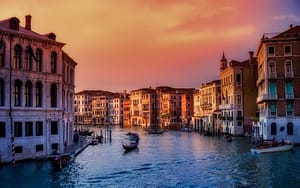Venice developed a creation myth that it was founded by people fleeing Troy, but it was probably formed in the sixth century C.E., when Italian refugees fleeing Lombard invaders camped on the islands in the Venice lagoon. Over the next few centuries, Venice developed as a trading center, happy to do business with both the Islamic world as well as the Byzantine Empire, with whom they remained close. Indeed, in 992, Venice earned special trading rights with the empire in return for accepting Byzantine sovereignty again. The city grew richer, and independence was gained in 1082.
The twelfth century saw Venice and the remainder of the Byzantine Empire engage in a series of trade wars, before the events of the early thirteenth century gave Venice the chance to establish a physical trading empire: Venice had agreed to transport a crusade to the ‘Holy Land,’ but this became stuck when the crusaders couldn’t pay.
Venice’s decline began in 1453, when Constantinople fell to the Ottoman Turks, whose expansion would threaten, and successfully seize, many of Venice’s eastern lands. In addition, Portuguese sailors had rounded Africa, opening another trading route to the east. Expansion in Italy also backfired when the pope organized the League of Cambrai to challenge Venice, defeating the city. Although the territory was regained, the loss of reputation was immense. Victories such as the Battle of Lepanto over the Turks in 1571 did not halt the decline.
The Venetian Republic came to an end in 1797, when Napoleon’s French army forced the city to agree to a new, pro-French, ‘democratic’ government; the city was looted of great artworks. Venice was briefly Austrian after a peace treaty with Napoleon, but became French again after the Battle of Austerlitz in 1805, and formed part of the short-lived Kingdom of Italy. The fall of Napoleon from power saw Venice placed back under Austrian rule.
Further decline set in, although 1846 saw Venice linked to the mainland for the first time, by a railway, and the number of tourists began to exceed the local population. There was brief independence in 1848–9, when revolution ousted Austria, but the latter empire crushed the rebels. British visitors began to speak of a city in decay. In the 1860s, Venice became part of the new Kingdom of Italy, where it remains to this day in the new Italian state, and arguments over to how best treat Venice’s architecture and buildings have produced conservation efforts that retain a great sense of atmosphere. Yet the population has fallen in half since the 1950s and flooding remains a problem.

